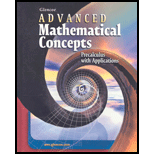
a.
To find:an inequality that represents the weight (in pounds) of packages carried by the truck.
a.
Answer to Problem 5CFU
Explanation of Solution
Given information:
Weight withstand by truck = 4200 pounds
Maximum weight of small package for delivery = 25 pounds
Maximum weight of large package for delivery = 50 pounds
The number of small packages and large packages are denoted by
Calculation:
The inequality representing the weight (in pounds) of packages carried by the truck is
b.
To find: an inequality that represents the volume (in
b.
Answer to Problem 5CFU
Explanation of Solution
Given information:
Volume of truck =
Maximum volume of small package for delivery =
Maximum volume of large package for delivery =
The number of small packages and large packages are denoted by
Calculation:
The inequality representing the volume of packages carried by the truck is
c.
To graph: the system of inequalities.
c.
Explanation of Solution
Given information:
The inequalities evaluated in part a. and b. are as follows:
Calculation:
Each inequality has les than or equal to sign, so the graph of each inequality will have a solid line.
First create a table of values for
| 0 | 120 | 168 | 500 | 1000 | |||
| 84 | 24 | 0 | 584 |
| 0 | 60 | 120 | 160 | 800 | |||
| 96 | 60 | 24 | 0 | 216 |
Plot the points and join them with a straight line. Now test a point to shade the region that represents the solutions for both the inequalities as shown below.
| Test point | True / False | |
| True | ||
| False |
| Test point | True / False | |
| True | ||
| False |
Nowshade the common region where the true point lies but remember the weight and volume cannot be negative. The graph of the given inequalities is shown below.
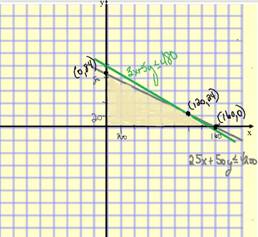
d.
To find: function that represents the amount (in $) of delivery service made on each truckload.
d.
Answer to Problem 5CFU
Explanation of Solution
Given information:
Service charge for small package = $5
Service charge for large package = $8
The number of small packages and large packages are denoted by
Calculation:
The function that representing the amount (in $) of delivery service made on each truckload is
e.
To find: number of each type of package to be placed in order to maximize the revenue.
e.
Answer to Problem 5CFU
Small packages = 160
Large packages = 0
Explanation of Solution
Given information:
The function evaluated in part d. for the maximum revenue is
The graph drawn in part c. is shown below.
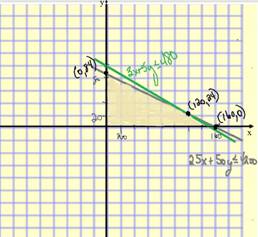
Calculation:
The vertices of shown in the graph are
Since the value for
f.
To find: maximum revenue per truck.
f.
Answer to Problem 5CFU
$800
Explanation of Solution
Given information:
The function evaluated in part d. for the maximum revenue is
The graph drawn in part c. is shown below.
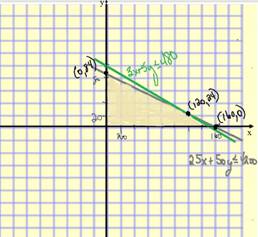
Calculation:
The vertices of shown in the graph are
Since the value for
g.
To explain: whether maximizing the revenue necessarily the best thing for the company to do.
g.
Answer to Problem 5CFU
Probably not
Explanation of Solution
Given information:
The function evaluated in part d. for the maximum revenue is
The graph drawn in part c. is shown below.
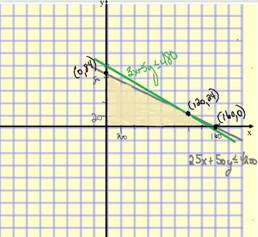
Calculation:
The vertices of shown in the graph are
Since the value for
Chapter 2 Solutions
Advanced Mathematical Concepts: Precalculus with Applications, Student Edition
Additional Math Textbook Solutions
Single Variable Calculus: Early Transcendentals (2nd Edition) - Standalone book
Thomas' Calculus: Early Transcendentals (14th Edition)
University Calculus: Early Transcendentals (3rd Edition)
Precalculus
Precalculus (10th Edition)
Calculus: Early Transcendentals (2nd Edition)
 Calculus: Early TranscendentalsCalculusISBN:9781285741550Author:James StewartPublisher:Cengage Learning
Calculus: Early TranscendentalsCalculusISBN:9781285741550Author:James StewartPublisher:Cengage Learning Thomas' Calculus (14th Edition)CalculusISBN:9780134438986Author:Joel R. Hass, Christopher E. Heil, Maurice D. WeirPublisher:PEARSON
Thomas' Calculus (14th Edition)CalculusISBN:9780134438986Author:Joel R. Hass, Christopher E. Heil, Maurice D. WeirPublisher:PEARSON Calculus: Early Transcendentals (3rd Edition)CalculusISBN:9780134763644Author:William L. Briggs, Lyle Cochran, Bernard Gillett, Eric SchulzPublisher:PEARSON
Calculus: Early Transcendentals (3rd Edition)CalculusISBN:9780134763644Author:William L. Briggs, Lyle Cochran, Bernard Gillett, Eric SchulzPublisher:PEARSON Calculus: Early TranscendentalsCalculusISBN:9781319050740Author:Jon Rogawski, Colin Adams, Robert FranzosaPublisher:W. H. Freeman
Calculus: Early TranscendentalsCalculusISBN:9781319050740Author:Jon Rogawski, Colin Adams, Robert FranzosaPublisher:W. H. Freeman
 Calculus: Early Transcendental FunctionsCalculusISBN:9781337552516Author:Ron Larson, Bruce H. EdwardsPublisher:Cengage Learning
Calculus: Early Transcendental FunctionsCalculusISBN:9781337552516Author:Ron Larson, Bruce H. EdwardsPublisher:Cengage Learning





